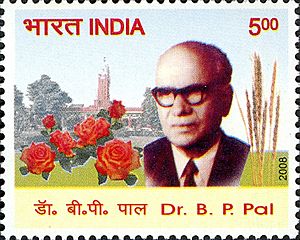Benjamin Peary Pal facts for kids
Quick facts for kids
Benjamin Peary Pal
|
|
|---|---|
 |
|
| Born | 26 May 1906 Mukandpur, Punjab, British India
|
| Died | 14 September 1989 (aged 83) |
| Alma mater |
|
| Awards |
|
| Scientific career | |
| Fields | Plant breeding |
| Institutions | Indian Council of Agricultural Research |
| Doctoral advisor | Rowland Biffen, Frank Engledow |
Benjamin Peary Pal, also known as B. P. Pal, was a famous Indian scientist. He was born on May 26, 1906, and passed away on September 14, 1989. Dr. Pal was a plant breeder and an agronomist. This means he studied how to grow plants better and how to improve crops.
He led important research institutes in India. He was the director of the Indian Agricultural Research Institute. Later, he became the first Director General of the Indian Council of Agricultural Research. Dr. Pal did a lot of work on wheat, especially making it stronger. He also loved roses and worked with different types of them.
Contents
Early Life and Education
Benjamin Peary Pal was born in Mukandpur, India. He was the youngest child of Dr. Rala Ram and Inder Devi. His family was from Jalandhar. However, his father worked in Burma as a medical officer.
He was first named Brahma Das Pal. But he changed his name to Benjamin Peary Pal in 1914. This happened when he was at St. Michael's School in Maymyo. A rose garden at his school might have made him interested in roses early on.
University Studies
Dr. Pal studied at Rangoon University. He earned his Bachelor of Science (BSc) and Master of Science (MSc) degrees there. For his master's, he studied a type of algae called Charophyta found in Burma.
After this, he went to the University of Cambridge in England. There, he worked on his PhD. His studies focused on making wheat stronger and healthier. He learned from famous scientists like Rowland Biffen and Frank Engledow.
Career and Research
After finishing his studies, Dr. Pal returned to India. He started his career as a rice research officer in Burma in 1932. Later, he moved to Pusa in Bihar, India. There, he became an economic botanist.
Leading Agricultural Research
In 1937, he became the Imperial Economic Botanist. This was at the Imperial Agricultural Research Institute. An earthquake caused the institute to move to New Delhi in 1936. Dr. Pal moved with it.
In September 1950, he became the director of the institute. He led many important research projects there.
Developing New Wheat Varieties
Dr. Pal is well-known for his work on wheat. In 1954, after 18 years of hard work, he developed a special type of wheat. It was called 'NP 809'. This new wheat variety was very important. It could fight off all three types of rust. Rust is a serious disease that harms wheat crops.
He also worked on making wheat resistant to other diseases. He helped create several new types of wheat. These new varieties helped farmers grow more food.
Director General of ICAR
In 1965, the Indian Council for Agricultural Research (ICAR) was reorganized. Dr. Pal became its first Director General. He worked in this important role until he retired in 1972.
Contributions to Societies
Dr. Pal did more than just research. He also helped create important scientific groups. He founded the Rose and Bougainvillea Societies of India. He also started the Indian Society of Genetics and Plant Breeding. He even served as the editor for its journal.
Awards and Honours
Dr. B. P. Pal received many awards for his great work.
- In 1959, he was given the Padma Shri.
- In 1968, he received the Padma Bhushan.
- In 1972, he was elected a Fellow of the Royal Society (FRS). This is a very high honour for scientists.
- In 1987, he was awarded the Padma Vibhushan. This is one of India's highest civilian awards.
Dr. Pal never married. He donated his property to the Indian Council of Agricultural Research. A beautiful rose garden at the Indian Agricultural Research Institute is named in his honour.

